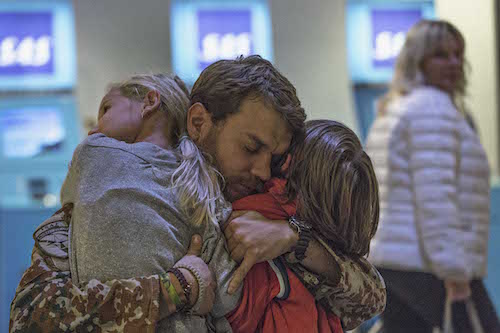-
Just before the release of their new record, Syracuse’s synth popper’s Ra Ra Riot played a stripped down show at Brooklyn’s Rough Trade. Vocalist Wes Miles, guitarist Milo Bonacci, bassist Mathieu Santos, violinist Rebecca Zeller, and drummer Kenny Bernard joined the audience on the floor of the venue, standing maybe a foot from the front row. The band formed a haphazard circle of mic stands and instruments. In that formation they looked more like a handful of buskers than a band. It was an excellent setting for the soft vocals and synth-soaked songs of the new Ra Ra Riot.
Latest News
- 8 years ago
-
There was once a professor who consistently lamented people not spending time with a work of art. She felt that consuming art became speedy, mediums were not fully appreciated in their details, and therefore a lot of great artwork may never get proper recognition. It’s safe to say this is true for many people, and even those like myself who studied art have definitely overlooked pieces due to the extreme saturation of available art to see, especially in a metropolis like New York City (though it is something I greatly try to avoid while in a space.)
I was stuck in front of Scott Williams’ painting 50th Street Maspeth this past weekend, due to the intimate space at Art101 being packed with people, but I’m glad I was. His work first appears like an impressionistic modern landscape – a view of the street, cars parked, sunny day, fence to the side – but the more I stared at it the more odd I found it. I noticed his use of perspective is based on traditional one-point perspective yet it is shifted off to the side thereby disrupting the everyday banality of this type of setting. Furthermore, his use of oil paint appears both deliberate, in regards to shadowing and color, and accidental in regards to the application of paint itself. This imbues the scene with a sense of randomness and further complicates it. He writes of his “chance” paintings – “For on site, ‘plein air painting’, a map of Queens and Brooklyn was marked with gridded coordinates. Throwing numbered and lettered coins lead to a location on the map at which, over several sessions, a painting is completed.”
Randomness is also an integral part of his portrait series. He places an ad on Craig’s List, not for models, but for anyone to show up at his studio and post for a painting. He has no screening process, and paints anyone who contacts him and physically shows up. He asks them to take a chance on him, and he subsequently takes a chance on them. The portraits are trials in understanding and depicting the particular nature of the sitter. While quite a few are distanced, there are some that capture a sense of intimacy despite the meeting of artist and sitter happening so soon. His use of paint is in keeping with his landscapes as well, which ties right into the dichotomy of planned versus random in his work. If you look closer, and for no longer, the veil of the banal is lifted and what I was left with was a surprising sense of intrigue for both landscapes and the individuals in a few of his portraits.
Both can be seen at Art101’s latest group show that opened this past Friday, and closes March 27th.
-Sabeena Khosla-
- 8 years ago
-
On February 14, celebrated fashion designer Tracy Reese’s intimate Fall 2016 collection paid respects to her hometown of Detroit, while tipping its hat to new innovations in runway presentations. And as part of all the newness, a nine-minute film called Detroit Love Story, helped to round out the loving tribute to her beloved city.
Design elements in Reese’s Fall/Winter Ready-To-Wear includes bold patterns like florals, plaid and herringbone, and retro-inspired polka dots, calf-length coats and garter socks.
Find out more about Reese’s fashionable hometown love affair after the jump!
- 8 years ago
-
Danish director Tobias Lindholm’s masterful new film, A War, is an exceptionally intelligent and sensitive depiction of the War in Afghanistan, both the complicated moral issues faced by occupying troops and the toll on their families back home. That’s not to say that this Oscar nominee for Best Foreign Language Film isn’t gripping or that its action sequences lack punch – one battle sequence is particularly pulse-pounding and stomach-churning. Shot in a straightforward style, the movie is never spectacular or overblown; Lindholm largely lets the situation’s drama speak for itself. A War follows CO Claus Pedersen (Pilou Asbæk, who previously starred in Lindholm’s A Hijacking) and his unit – who are trying to weed the Taliban out of an Afghan province while protecting civilians – as well as Pedersen’s family in Denmark.
The tense vibe of the film is set early on when Claus’s unit is out on patrol. Sure enough, a young gunner is suddenly caught in a mine explosion, a horrific scene that brings home the unpredictability of the unit’s every mission as well as its close camaraderie. The CO – a tough but decent sort – is sympathetic to one soldier (Dulfi Al-Jabouri) who is badly shaken up by the incident, putting him on camp duty for a few weeks. Claus himself will replace both men on patrols, though it is not his usual role.
Meanwhile in Denmark, his wife Maria (Tuva Novotny) is dealing with their three young children, one of whom is having disruptive behavioral issues. She’s upbeat, but clearly feeling the strain. The family’s days are scheduled around phone calls from Claus, who can’t always call when expected.
Back in Afghanistan, while patrolling a civilian compound, Claus’s unit comes upon a hysterical man who asks them to help his injured daughter. Later the man and his family show up at the soldiers’ camp seeking refuge. We see the tough decisions the troops must make when dealing with civilians, as well as the desperation and frustration of Afghans who are caught between the Taliban and occupying soldiers who are alternately friendly and roughly suspicious.
The next day, as Claus’s unit attempts to secure the family’s compound, it is attacked and the scene suddenly becomes frantic and chaotic; though we’ve seen similar depictions of soldiers under fire, it’s still shocking, their panic palpable. One soldier is hit and in an attempt to save him and prevent further devastation, Claus orders the bombing of the compound. The rest of the film deals with the consequences of Claus’s action on himself and his family, as he must make another major decision when he is called to testify in court. Thanks to a fine, sympathetic portrayal by Asbæk, we feel his ordeal.
During the course of A War, we’re pulled by different, sometimes conflicting, emotions – sympathy, disgust, unease – which seems to be the point. Several issues come to the fore: the ease with which we (civilians) judge military actions; the complicated responsibility of being a military presence in another nation; the difficulty of protecting helpless civilians while trying to protect oneself and one’s comrades. There’s also the interesting matter of watching European troops, rather than the Americans we’re generally used to seeing, in this situation. It allows for more objective viewing, in a way, without feelings of national responsibility/pride/shame, etc., getting in the way, so it can be better appreciated as pure drama. Still very disturbing, of course, but not specifically to us as Americans.
A War is a realistic, clear-headed picture of a morally complex issue that has no clear-cut answers, though it certainly will encourage discussion. The film is tough but also tender, powerful and poignant, without the macho bluster of many war movies. That’s refreshing in itself.
A War opens on Friday at Landmark Sunshine Cinema.
—Marina Zogbi
- 8 years ago
-
Forget this year’s Oscars! The 2016 Screen Actors Guild Awards offers a wildly gorgeous array of surprisingly fresh looks that will surely influence future fashion to come. (It also showed that 69-year-old Susan Sarandon is still too legit to quit.)
The January 30th telecast, featured television and film luminaries wearing unpredictably dope designs from up-and-comers including Erdem and Peter Pilotto.
To use two-time 2016 SAG Award winner Idris Elba words to best summarize the gowns seen at last night’s SAG Awards: “Ladies and gentlemen, welcome to diverse TV.”
Check out five stand-out progressive styles that’s definitely pushing awards show fashion forward.






